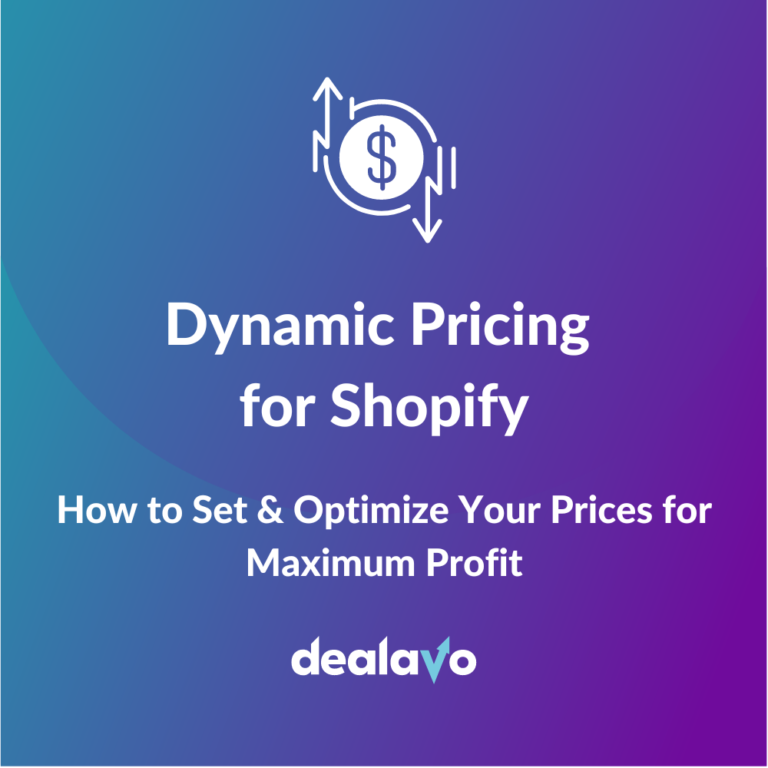Repricing Guide: What it Means, How it Works
- 16 August 2023
Are you confused about what repricing actually is? Do you know how it works and the implications of using a repricing strategy in your business? Don’t worry–we understand this can be tricky to wrap your head around. That’s why we’re here to remove all the mystery surrounding repricing and explain precisely what it means and why implementing an effective pricing strategy is essential for any successful ecommerce company. In this blog post, we’ll break down the basics of repricing so that you can use this knowledge to make more informed decisions in terms of how best to price your products going forward. Read on to learn more!

Defining Your Pricing Strategy/Repricing
Establish your competition clearly
Many online businesses often misunderstand who their competition truly is. They might not realize the significance of some competitors, or they might forget about small shops, online marketplaces, and websites that compare prices.
To handle this situation better, take your time to look at all your competitors. Doing this will help you avoid making changes to your prices just because others are doing it. Instead, you can make smarter decisions for your online business that are based on your own analysis and goals.
Divide your products into categories/groups of products
Organizing your products into different categories based on their characteristics can greatly assist you in keeping track of your competitors’ alternatives. This simple step will actually simplify the process of identifying differences in their prices and keeping an eye on them. By doing so, you’ll be better equipped to stay informed about your market and competitors without much hassle.
Identify price fluctuations that occur in the market
This will help you with recognizing times of the year when sales are higher and moments when demand peaks. It involves ensuring that your repricing tool is set to go and that your e-commerce inventory is ready for various changes in the market. By doing so, you’ll be well-prepared to adapt to different buying patterns and maximize your profits.
Get yourself a reliable Repricing Tool
Having a repricing tool is essential for implementing your repricing strategy effectively and benefiting from it. A dependable monitoring software offers all the tools required to consistently stay ahead of your competitors. This software simplifies the process of making important decisions, whether they pertain to products, prices, advertisements, or suppliers. With this tool at your disposal, you can make well-informed choices to enhance your business.
How to Correctly Implement a Repricing Strategy?
Repricing is particularly helpful for e-shops with a wide range of different products. The main advantages of implementing repricing strategy in your shop are:
- Higher profits – Repricing spots opportunities for higher profits much better than anyone could do it manually. What’s more, it automatizes the pricing process and adjusts it by given circumstances such as lack of availability in stores of your competitors
- Time savings – Manually adjusting prices is nothing but a nightmare and a real energy drainer. Our system will match the prices accordingly, and you can always control the results of recent repricing actions in a transparent panel.
But how to get started with a repricing strategy?
To begin, you select the products you want to set automatic prices for.
Next, you define the rules that will determine these prices. These rules can be tailored for different product categories, sales channels, and locations.
Using information gathered from the market and your ERP systems, the system suggests prices for your store. You can opt to let your prices change automatically using Dealavo’s calculations. Alternatively, you can choose to approve each suggested change before it’s implemented on the sales channels.
It’s also essential to monitor the outcomes of your actions. This involves assessing whether the pricing rules you’ve set are yielding the best results. Experimenting with different repricing rules is also a valuable approach to consider.
See how to implement repricing strategies with Dealavo!
Algorithmic Vs. Rule-Based Repricing: Which Is Best for Your Internet Shops?
Repricing software available in the market generally falls into two categories: rule-based and algorithmic. Both types are effective for helping you adjust the prices of your ASINs (Amazon Standard Identification Numbers) to stay competitive on Amazon’s platform. However, these two options yield different outcomes. So, how do you decide which one to go for?
Rule-based Repricing
Rule-based repricing offers sellers a hands-on approach to modifying prices in response to their competitors. With this method, sellers manually establish pricing rules based on various scenarios and factors, guiding the repricer on how to set prices in relation to competitors. Additionally, sellers can set their desired price range for items using percentages or currency and evaluate the outcomes.
These rules empower sellers to adjust prices higher, lower, or in line with rival prices. Whether it’s about maintaining competitiveness or maximizing profits once you’ve secured the Buy Box, the flexibility is yours. You can even customize your competition criteria by considering fulfillment methods and feedback ratings. Importantly, these rules work harmoniously to ensure optimal pricing without conflicting with each other.
Even when no direct competitors exist, you have the option to set rules that maximize profits for your products.
Advantages of Rule-based Repricing:
- Provides complete control over price adjustments.
Disadvantages of Rule-based Repricing:
- The setup process is time-consuming and can be complex to avoid rule conflicts.
- The available scenarios and factors for repricing might be limited and inflexible due to software constraints from the repricing provider.
- Creating rules might carry a slight bias.
- Market dynamics constantly change, necessitating regular rule updates to remain current.
- Since human analysis of market trends takes time, rule-based repricing cannot respond in real-time to exploit growth opportunities.
Algorithmic Repricing
Algorithmic repricing is a smarter tool that uses AI algorithms to determine the best price based on current market conditions. By analyzing market trends and considering various metrics, it helps sellers set competitive prices. These metrics include factors that influence the likelihood of winning the Buy Box. Many AI algorithms utilize machine learning to forecast pricing trends. The more you use repricing over time, the better these algorithms become at predicting prices and optimizing your listings.
Advantages of Algorithmic Repricing:
- Simple and Quick Setup: Getting started is easy and doesn’t take much time.
- Reduced Human Bias: Machine learning algorithms rely on data, minimizing human biases.
- Improved Buy Box Performance: It enhances your chances of winning the Buy Box and increases your Buy Box percentage.
- Holistic Analysis: Algorithms consider various factors beyond just your competitor’s price, which can improve profitability and Buy Box opportunities.
- Adaptation to Market Changes: Continuous learning from historical data and competitor behavior allows algorithms to adapt to evolving market trends.
- Time and Effort Savings: Using algorithms frees up your time and effort, enabling you to focus on other aspects of your business and personal life.
Disadvantages of Algorithmic Repricing:
- Reduced Control: Sellers might feel they have less control over price changes, which could be a drawback for those who prefer greater control in their business decisions.
- Higher Costs: Algorithmic repricing is a more advanced technology, making it relatively more expensive compared to other options.
Make a Difference with Data-Driven Repricing: a must-have on marketplaces
Repricing lets you establish various pricing rules for different online marketplaces like Amazon, Ebay, Idealo, and Google Shopping. This flexibility allows you to adapt to each platform’s unique environment.
Price segmentation, through this approach, offers several advantages. By tailoring your prices to specific marketplaces, you can attract more customers and potentially boost sales. Moreover, you can better respond to competitors’ pricing strategies and changes in demand, helping you stay competitive.
However, there are also challenges involved. Managing multiple pricing strategies might become complex and time-consuming. It’s crucial to maintain a balance between optimizing prices for each marketplace and keeping your overall pricing strategy coherent. Additionally, constantly monitoring market trends and adjusting prices accordingly can be demanding. That’s why you will need a reliable tool.
But first, take a look on how repricing works for various marketplaces.
How does repricing help Amazon sellers?
As one of the world’s largest online retailers, Amazon has become a go-to destination for millions of consumers looking for everything from household items to electronics. However, with such a vast seller network, competition can be fierce. This is where repricing comes in handy for Amazon sellers.
By implementing repricing strategies, Amazon sellers can maximize their sales and profits. It helps them win the Buy Box more frequently by offering competitive prices compared to other sellers. The Buy Box is a prominent feature on Amazon that significantly impacts product visibility and sales.
Moreover, repricing enables sellers to optimize their pricing strategy based on different scenarios. For example, they can set higher prices when demand is high or lower prices when they want to clear excess inventory.
Retailers can also track Amazon prices whether they are a seller or a manufacturer and want to determine deviations from MSRP prices (suggested prices).
If you operate in the USA, you can track MAP prices (minimal prices) as well. In the same way, you can use our platform to monitor price violations.
How does Idealo repricing work?
Idealo is a price comparison platform that allows shoppers to compare prices from various online retailers, so repricing is essential for sellers to remain competitive and attract customers.
So how does Idealo repricing work?
Idealo repricing works by employing advanced algorithms and data analysis to dynamically adjust product prices on the Idealo marketplace.
Repricing software gathers data from various sources, including the Idealo platform itself and other competitors’ listings. This data includes information about product prices, availability, seller ratings, shipping costs, and more.
The repricing algorithm analyzes the data to identify your competitors’ pricing strategies. It takes into account factors like pricing trends, the competitiveness of your offers, and market demand
Sellers can set specific repricing rules based on their preferences and business goals. These rules dictate how the repricing algorithm should adjust prices in response to different scenarios. For example, a seller can choose to price their products slightly lower than the lowest competitor to attract more attention.
Idealo repricing is an ongoing process. Sellers need to continuously monitor the effectiveness of their repricing strategies and make adjustments as needed to adapt to evolving market conditions and competitors.
How does Ebay repricing work?
With more than 150 million active users, eBay remains a significant marketplace and the largest auction website. According to statistics, eBay:
- Offers more than 1.5 billion listings.
- Achieved revenue of 10.2 billion USD in 2020.
- Attracts over 109 million visitors monthly.
- Enjoys popularity across various markets, including the US, Canada, Australia, France, Italy, Germany, and Spain.
As a result, it presents a favorable opportunity for your business to enter. However, it’s crucial to consistently observe and optimize your pricing strategy. This will ensure satisfactory profits and optimal visibility for your listings. This is where Dealavo comes in, featuring its ‘dynamic prices’ functionality. By implementing the Dynamic Pricing approach, you can establish predetermined pricing rules, such as positioning your product among the top five listings in a specific product category on eBay. Furthermore, our platform employs machine learning and AI-powered algorithms, ensuring full automation of these processes.
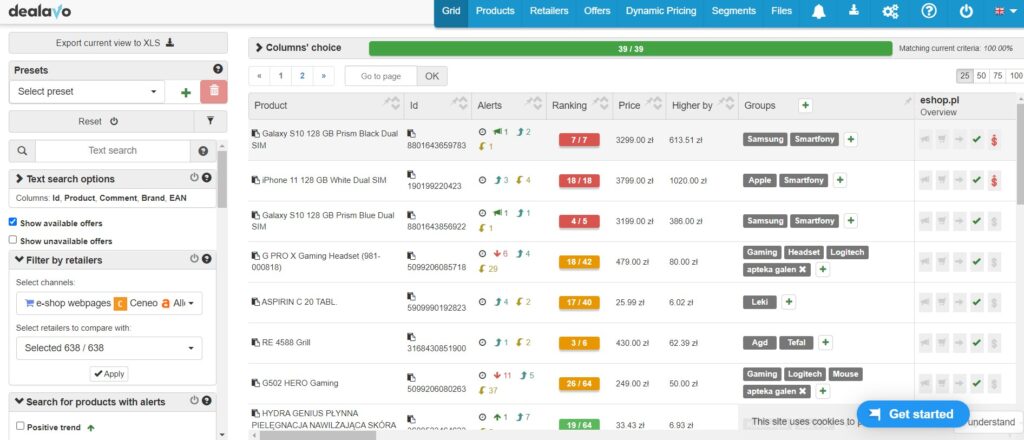
Dealavo price monitoring & dynamic pricing tool works with any marketplace you need
How does Google Shopping repricing work?
The Google search engine is a very powerful tool that people all over the world use to find specific products. That’s why Google Shopping is the second most popular platform after Amazon for both customers and sellers to search, compare, and buy products.
Even though Google Shopping helps you compare prices, it mostly promotes products from companies that work closely with Google Corp. This means that using an independent tool to monitor prices can give you a better and more accurate understanding of the market.
Also, Google Shopping is a competitive place for sellers, especially those who are just starting out. But whether you’re experienced or new, you’ll still need to adjust to changes in the market.
Even though Google Shopping doesn’t have a Buy Box like Amazon or eBay, the prices you set are still really important for how often your products show up in search results. If your prices are competitive, more people will see your products.
This is where Dealavo’s Dynamic Pricing algorithms can be helpful. With the right strategy, you can use Dynamic Pricing to keep an eye on prices, use different tactics, set rules for your prices, and react quickly when your competitors change their offers or products.
Are you struggling with your Google Shopping Ads campaigns?
On Which Platforms Is Repricing Applicable?
In the dynamic world of e-commerce, the versatility of repricing knows no bounds. Whether you’re harnessing the power of Woocommerce, navigating the features of Shopware, maximizing opportunities on Shoper, or embracing the user-friendly interface of Shopify, repricing is a tool that transcends platforms.
From small-scale entrepreneurs to established businesses, the ability to adapt and optimize pricing strategies remains a crucial element in staying competitive and capturing the attention of discerning shoppers. Regardless of the digital landscape you choose to conquer, repricing stands as a valuable asset, paving the way for increased visibility, enhanced sales, and a thriving online presence.
Repricing Software You Should Know
Dealavo
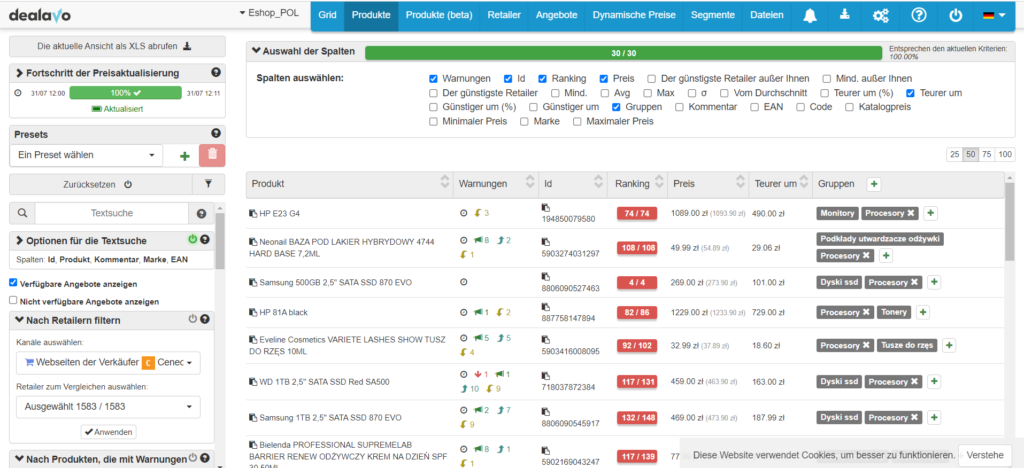
Dealavo is a price monitoring and repricing tool that enables swift analysis of prices and product availability in the e-commerce market. Through its repricing module, online stores can automatically adjust prices according to the current market situation based on predefined rules. The new ROAS Booster service allows leveraging competitor data for optimizing Google Ads campaigns. This tool aids in boosting sales profits by implementing effective pricing strategies and saving time on market analysis. Dealavo operates internationally, monitoring thousands of websites across over 30 countries.
Prisync

Prisync functions as a valuable solution designed mainly for online stores, equipping them to oversee competitors and formulate efficient pricing tactics. It has gained recognition for its smooth data import and export processes, along with its accurate tracking of prices and product availability.
For enterprises seeking a reliable dynamic pricing remedy, Prisync distinguishes itself with its user-friendly and intuitive user interface. Remarkably, it shines in customer service, setting it apart from other comparable tools in the market.
Price2Spy
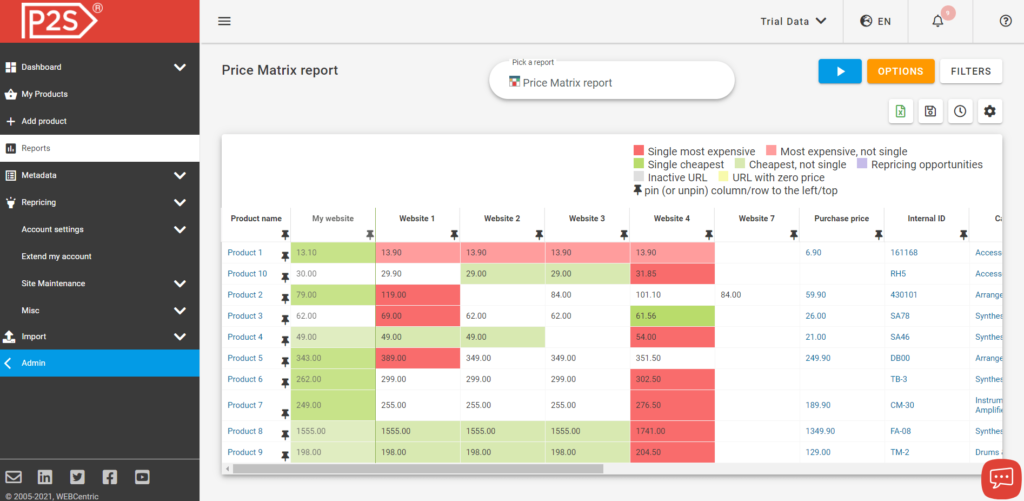
Price2Spy is a pricing tool for stores that uses Machine Learning and Artificial Intelligence. This helps different experts understand prices better and achieve good outcomes. The software can check any website, even if it seems hard. Price2Spy has useful features like demos, tutorials, and online help. Yet, some reports from the tool might be a bit tricky to understand.
Intelligence Node
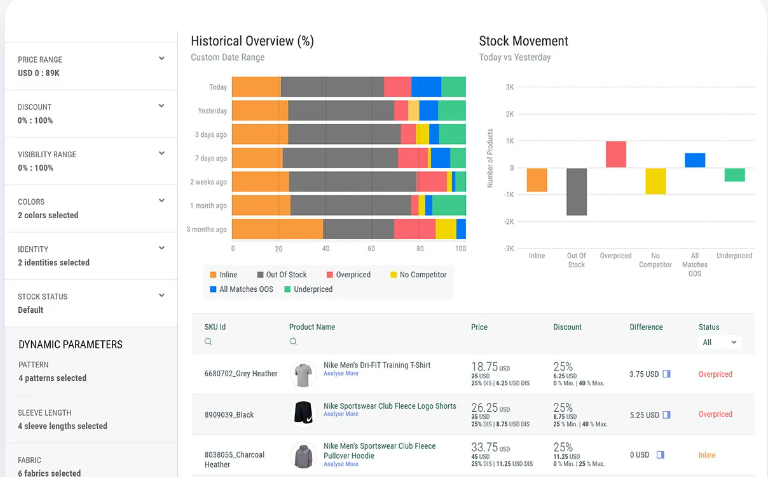
Intelligence Node has different parts: pricing & deals, product range & stock, brand solutions, and online shelf analysis. What’s important is that IntelligenceNode is really accurate, getting 99% of the data right. It’s worth mentioning that many big companies like Prada, Lenovo, Nestle, and LIDL use this platform. Together, these companies make more than $600 billion in sales around the world.
Competera
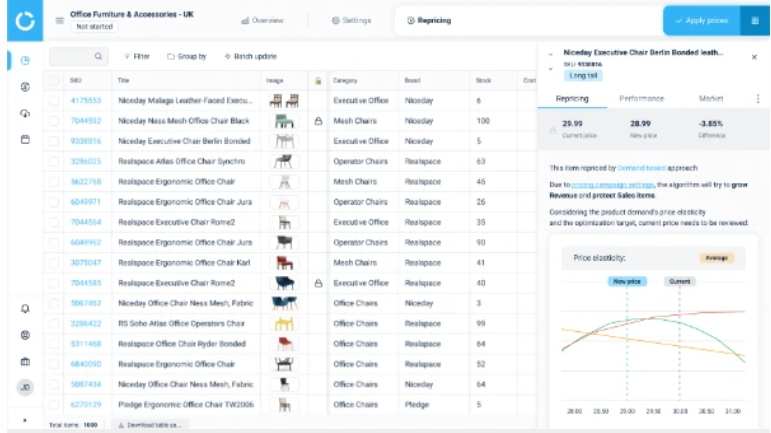
Here’s a simpler rewrite:
Competera tool uses both Artificial Intelligence and Machine Learning. It works for all kinds of businesses, whether they sell online, in physical stores, or have many brands. Competera stands out because it combines competitive data and helpful tools, regardless of a company’s goals. They have different products like Competitive Data and Pricing Automation. Some people say the tool could have more detailed stats about the data it gives.
Repricing FAQ from Dealavo Experts – when do you need repricing?
What is repricing and how does it work?
Repricing is a strategy that allows brands to react to changes in the market quickly. Whether it’s the product’s price, demand, supply, or changing trends that lead to market variations, dynamic pricing is something that comes in handy and enables retailers to adapt their prices in every situation.
This strategy (also known as dynamic pricing strategy) is based on setting as competitive prices as possible. Whenever other competitors change their prices, repricing should be considered to remain the brand’s competitiveness. You can do it manually or (what is more recommended) use a dedicated tool for it.
Do you need to automate product pricing decisions?
Absolutely, if you’re looking to streamline your pricing strategy and stay competitive in the dynamic market landscape, Dealavo’s solutions can help you automate your product pricing decisions effectively. By automating product pricing decisions, you can stay competitive without the manual effort of constant monitoring.
Whether you’re a new seller or an experienced retailer, automating product pricing decisions can save you time and help you achieve your pricing goals effectively.
How do repricing tools calculate the suggested price?
Repricing tools like Dealavo calculate the suggested price by considering a variety of factors that influence market dynamics. Our advanced algorithms take into account competitor prices, market trends, historical sales data, and your own pricing strategy goals. We analyze this data to determine the optimal price that aligns with your business objectives, whether it’s winning the Buy Box, maximizing profits, or maintaining a competitive edge.
I already have repricing software but have trouble implementing it. Can you help with that?
Of course, we’re here to assist you with that exact concern!
Our team of experts at Dealavo specializes not only in providing top-notch price monitoring and repricing solutions but also in guiding you through the implementation process.
If you’re facing challenges with setting up your repricing software, our experts can help you navigate through the intricacies, ensuring a smooth and effective implementation.

